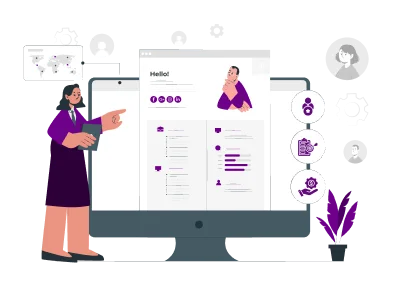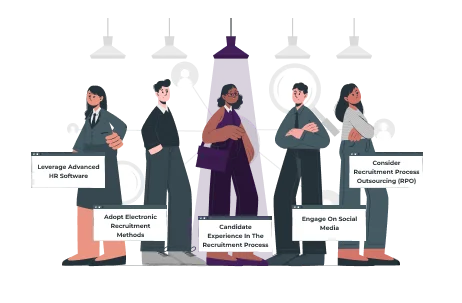Recruitment in HRM is the process of finding out real talent for your company. It includes steps such as attracting and contracting appropriate human resources for use or potential use in the organization.
Grab a chance to avail 6 Months of Performance Module for FREE
Book a free demo session & learn more about it!
-
Will customized solution for your needs
-
Empowering users with user-friendly features
-
Driving success across diverse industries, everywhere.
Grab a chance to avail 6 Months of Performance Module for FREE
Book a free demo session & learn more about it!
Superworks
Modern HR Workplace
Your Partner in the entire Employee Life Cycle
From recruitment to retirement manage every stage of employee lifecycle with ease.


Seamless onboarding & offboarding
Automated compliance & payroll
Track performance & engagement
A Step By Step Process Of Recruitment In HRM: Essential Guide
- Recruitment Analytics
- 8 min read
- August 30, 2024

Employees are assets! For that, you need proper recruitment and selection in HRM.
The right recruitment of employees is one of the important steps in the success of a firm. This recruitment human resources process entails attracting, selecting, and hiring candidates for different job roles.
This operation is supposed to be conducted by the HR and recruitment department. So that the organization can have staff with adequate skills and qualifications. A structured end-to-end recruitment process is highly important in finding and hiring top talents.
The key stages and sources of recruitment in HRM are highlighted in this comprehensive guide, where we look into strategies and factors affecting recruitment in HRM.
What Is Recruitment In HRM?
Recruitment definition and process: Recruitment in HRM is the planned procedure of identifying and attracting applicants for a particular position in the company! Recruitment is the beginning of any organization’s strategy geared toward securing talent to grow the company.
In the technological world, recruitment strategies have taken a considerable turn. The acceptance of e-recruitment in HRM and the HR software for recruitment has revolutionized how businesses connect with potential candidates. This sort of online recruitment system allows organizations to cast wider nets, reaching a larger, more diverse talent pool, while the process is simplified.
Also, See: A Guide For The Role Of HR Employee Engagement & Satisfaction
Cut down your recruiting time up to 70% with expert tools!
Optimize your hiring strategy today with Superworks.
Main Purpose Of Recruitment In HRM
The main purpose of recruitment, therefore, is securing and employing the right kind of human resources. This can be capable of delivering the high level of performance required to achieve the organizational goals.
The right recruitment in management helps to add the right people to achieve its business goals. Good techniques of recruitment in HRM fill the vacancy instantly and even help build a talent pipeline for future requirements.
Now, let us discuss the key recruitment objectives of HRM:
– Enhance Hiring Success Rates
Different types of recruitment in HRM enhance the probability of hiring the best candidates.
In doing so, the recruitment and selection in HRM makes sure that through
- An intelligent review and evaluation of a large number of job applications,
- Weeding out the undesirable candidates
- Focus the attention on HR job candidates whose qualifications and experience match the job.
Advanced techniques of the recruitment process in HRM, such as the best HRMS payroll software in India and electronic tools of recruitment, make it possible for the organization to better assess the candidates. It helps the organization reduce employee turnover and increase overall productivity.
– Align with Organizational Goals
This is because recruiting in HRM helps the organization find a fit for its staffing requirements. With a sense of proper recruitment policy in HRM, the HR professional can revolutionize the recruitment process in HRM.
A strategic recruitment plan should not dwell on the number of people but rather on getting people who are the right fit.
– Ensure Smooth Business Operations
A properly conducted recruitment process in HRM ensures that the organization acquires the requisite human resources for sustained business operations. Filling up key position levels in the organization with the right candidates helps top 10 HR software in India prevent disturbances and function the business smoothly.
Also, managing diversity and inclusion is represented through the recruitment process.
– Optimize Operational Costs
The best recruitment practice is cost-saving under time and resource costs. These are incurred while finding and employing the right candidate. Tools for Recruitment that includes applicant tracking systems and candidate relationship management (CRM) systems enhances the efficiency of the hiring process.
Being systematic in recruitment may help organizations save much time, such as the time spent on résumé-screening and schedule-setting for interviews.
8 Important Steps For Recruitment And Selection
The key steps forward to any successful recruitment process in an organization. All of the steps are important to reach the most desirable candidates for your organization. Let’s take a closer look at the steps below:
1. Role Definition and Job Analysis
The first step is to define the role! It should be accompanied by a deep job analysis. This includes the key responsibilities of the job and the competencies and qualifications required for the job. A well-defined job will ensure the recruitment process should be most suitable for candidates applying for the job.
In this regard, job analysis is crucial for HR practitioners to collaborate with the heads of departments and team leaders. This stage of the recruitment process in HRM also comprises the analysis of the current workforce to determine the current gaps in skills. An explicit and detailed job description will draw a higher number of qualified candidates.
2. The Job Advertising
Following the job description fine-tuning, the next activity is strategic job advertising, which is accomplished by choosing the right media. Whether via job boards such as Naukri, Monster, etc; social media such as Linkedin; recruitment agency software; or industry-specific forums, the objective is to get the job posting.
For example, effective job advertising has much to do with knowing the best point at which to find the intended candidates.
3. Proactive Candidate Sourcing
Proactive candidate sourcing goes a mile further to involve the actual search for the candidates. This recruitment and selection may include headhunting, networking at industry events, and utilizing online recruitment system. Sourcing, moreover, becomes particularly important in finding passive candidates who may not be actively looking for a job.
This would also encompass a talent pool, a database, or a listing resource of persons who are probable candidates to be considered in the future.
4. Comprehensive Screening Process
This is a vital step in considering all but the best-qualified candidates for a particular job. This includes scanning resumes, cover letters, and applications to see which candidate has the necessary qualifications and experience. The process is done with the aid of advanced tools such as an applicant tracking system, which can automatically screen initial applications.
For example: If you want to do recruitment for HR, you need to screen all the candidates for the same. Check the position, get to identify the real talent, and give the offer to them.
Pre-screening interviews, either by phone or video, can further examine qualifications for the position. At this stage, human resource professionals can assess not only the qualifications of the candidate but many things.
5. Structured Interview Process
The interview process is a detailed assessment of the candidates. It usually involves several rounds like technical interviews, panel interviews, or behavioral assessments. This is supposed to chalk out how well the candidate will fit into the job requirement by the level of skill and culture.
Fair and consistent evaluation can be achieved only when structured interviews are held in which each candidate is asked the same set of questions. Situational and behavioral questions will provide a deeper insight into the probable real-life performance of the candidates.
6. Thorough Assessments And Evaluations
Depending on the role, candidates may be tested with technical, psychometric, or problem-solving exercises. The essence of this is to know the right qualities that would make them successful in that position.
Job-specific assessments can go to a level of coding tests in more technical positions. This means that, in addition to assessing candidates.
7. Final Decision and Offer Stage
Selection is the next process, executed after interviews and assessments. It involves comparing the performance of applicants in the whole recruitment process. An offer letter is sent to the selected ideal candidate.
This final decision should be taken incorporating the inputs from all who are party to taking interviews. Selection Once the selection has been done, the selected candidate should be offered the job at the earliest.
8. Onboarding and Integration
Onboarding is the final component in the recruitment process. In this step, the newly hired employee becomes acclimated to the organization through orientation meetings, training programs, and team integration activities.
It includes steps like:
- Introductions with key team members,
- Training in company policies and procedures,
- And setting expectations for the first few months.
Frequent check-ins will help solve any concerns the new employee might have well into the process of onboarding.
How To Do Smart Recruitment?
Smart recruitment ensures efficiency in the process by using technologies and data. Here’s how you can apply smart recruitment strategy:
– Leverage Advanced HR Software
Leverage the most advanced HRMS software in recruitment, which will automate and smoothen several parts of the hiring process. Such technologies as applicant tracking systems and recruitment analytics can facilitate application management.
– Adopt Electronic Recruitment Methods
E-recruitment is a short form of electronic recruitment, which means an online way of posting all job vacancies and receiving applications. This increases the scope and speed of recruitment, making capturing the best talent quite easy.
– Candidate Experience In The Recruitment Process
Smoothening the candidate experience is a very effective measure in acquiring and retaining top-tier talents.
– Engage on Social Media
Leverage social media in candidate sourcing and promoting employer branding. Keep the potential candidates engaged on LinkedIn for relationship-building and attract high-class resumes from the pool.
– Consider Recruitment Process Outsourcing (RPO)
Outsourcing of the recruitment process includes partnering with third-party experts who manage the function.
In these, all the solutions, prefer to get the HRMS and recruitment software such as Superworks. This can help you to identify real talent and make the process of recruitment as easy as possible. Let’s connect to know more.
FAQs
What Is The Recruitment In HRM?
What Are The 7 Stages Of Recruitment?
The 7 typical stages of recruitment include:
- Role definition and job analysis,
- Job advertising,
- Candidate sourcing,
- Candidate screening,
- Interviews,
- Final decision,
- Offer and onboarding.
What Is The Recruitment Process?
The recruitment process includes identifying, attracting, and screening, to choose the candidates fit for a job.
What Are The Three Types Of Recruitment?
The three types of recruitment are:
Internal recruitment,
External recruitment,
Third-party recruitment.
What Are The 5 Stages Of The Recruitment Process?
The 5 stages of the process are job role definition, advertising, candidate sourcing, candidate screening, and interviewing.













